In today’s hybrid workplace, listening can be harder than ever, with an influx of information battling for our attention. Leveraging open ended questions is one listening strategy that can help you truly understand what your team is thinking and feeling.
As a leader, listening is one of the most powerful skills you need to build trust within your team.
With 75% of workplaces now offering hybrid setups for employees, meetings are one of the very few places for connection and having the conversations you need to with employees.
Using intentional open text polls is one of the easiest and quickest ways to get the insights that you need at scale.
Incorporating open-ended questions into your polls can help you listen in an inclusive way, ensuring everyone’s voice is heard.
As Slido polls can be anonymous, they offer a safe space for employees to express their thoughts, without bias.
In this blog post, we’ll explore the art of asking open-ended questions, and how you can use them effectively to help break the ice in meetings, forge team connections, power brainstorming and solicit feedback.
What are open-ended questions?
Open-ended questions allow the person answering them to provide longer, more thought-out responses, and will often ask the question “why?”.
These types of questions promote deeper thought and discussion, leading to more meaningful insights – you might think of them as deep questions.
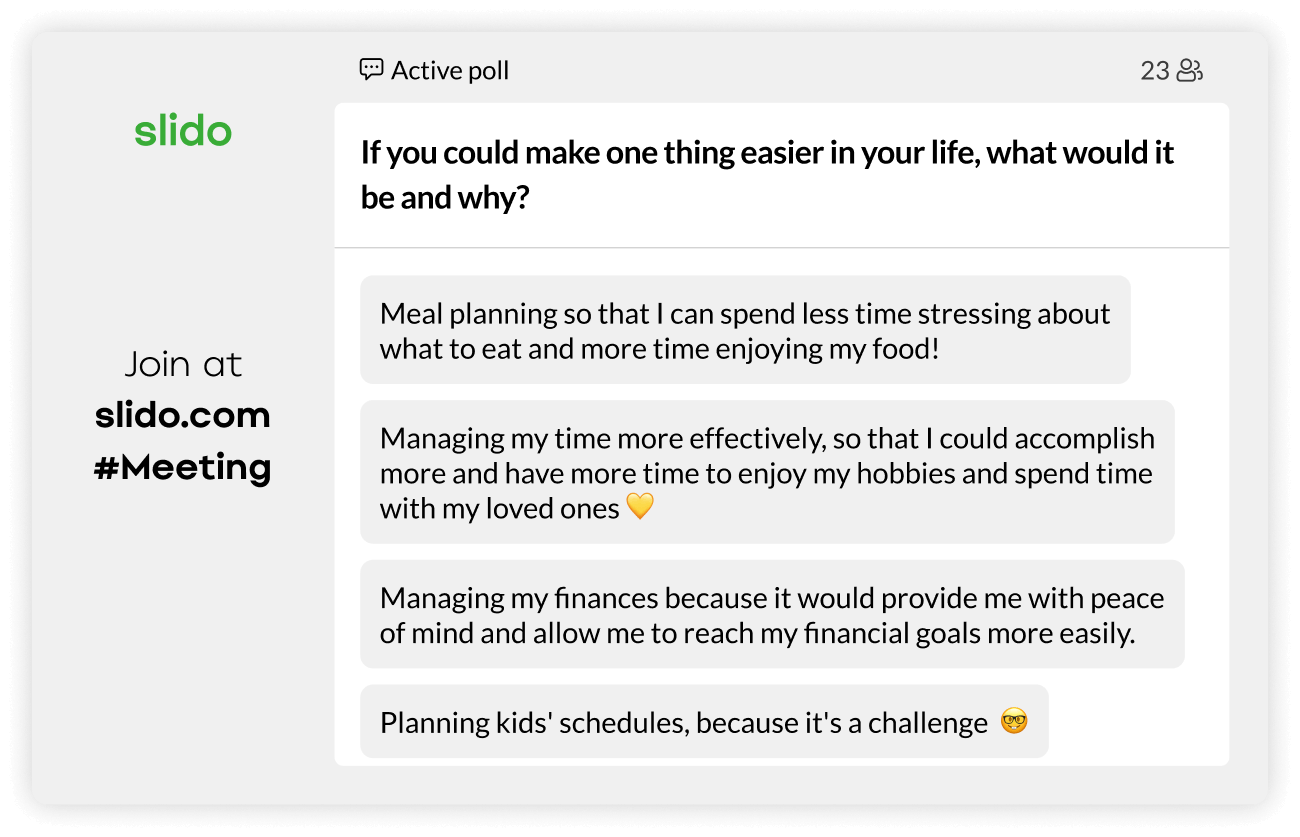
You’ll find a list of examples of open-ended questions here.
By understanding the “why” behind people’s actions or behaviors, we can gain more clarity and direction when making decisions – which is valuable information.
However, it’s important to remember that crafting effective open-ended questions requires thoughtfulness and creativity.
It’s crucial to frame them carefully to obtain concise and thoughtful responses, as well as making sure to use the right poll type.
Why is it important to ask open-ended questions to get honest feedback?
Open-ended questions allow you to get that bit deeper with insights and really work out what your team is thinking and feeling.
In a hybrid setup, without everybody in the office at the same time, leaders will want to be mindful of avoiding proximity bias.
While you can connect one-on-one with your team, maintaining that level of connection when you have a larger or distributed team can be tricky.
Asking these types of questions via polls helps to make sure that there’s a level playing field for teammates, no matter where they’re working.
Open-ended questions will help you to be even more intentional about your interactions to stay in touch with your employees.
They will also promote the development of relationships built on honesty and mutual understanding, which can increase a sense of trust and psychological safety within your company.
Open-ended vs close-ended questions
Slido is set up to facilitate both types, but there’s a difference between open-ended vs close-ended questions.
Open-ended questions typically ask for opinions, feelings or descriptions. While you’ll get more detailed answers from open-ended questions, one disadvantage is that it will require more time and resources to analyze the results.
Examples include feedback surveys and open-text polls.
If you’re short on time, or only require a simple vote or consensus, then a close-ended question might suit you better.
Close-ended questions are more structured and ask respondents to choose from a limited number of predetermined answers, such as “yes”, “no”, or choosing a ranking from one to 10. They often result in a single word answer.
Another example is a multiple choice poll with pre-set answers that participants have to choose from.
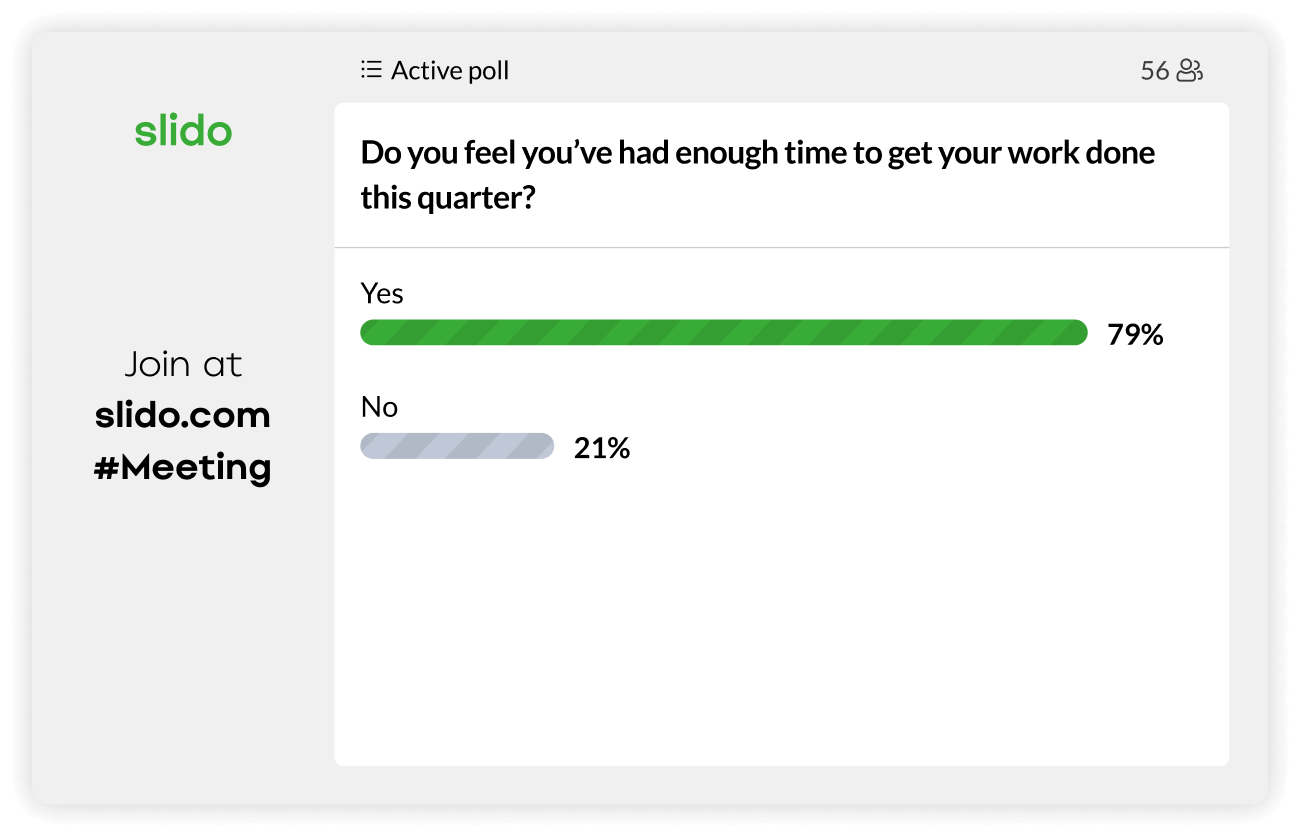
These questions provide fast, quantitative data that can be statistically analyzed more easily.
It’s important to note that while close-ended questions are easier to interpret, they may not capture the full range of experiences or opinions among respondents.
Sometimes, the answer may lie in using a combination of both question types. A good example of this is with a feedback survey, where you can run a quick rating poll, followed by an open ended question so that you can get the full picture from your survey questions.
How to ask open-ended questions
Here are a few helpful tips on how to craft open-ended questions, so that you’ll spark engaging conversations and encourage people to share their thoughts and ideas:
- Ask “why” or “how” — these types of questions encourage people to explain their thoughts in more detail.
- Ask questions that avoid “yes”, “no” or one-word answers.
- Be as specific as possible in what you’re asking. That way, respondents won’t feel overwhelmed by too broad a question.
- Keep questions short, clear and refined – the more complex, the lower the chances are of getting answers of good quality, so keep things simple.
- Avoid asking multiple questions within the same question – stick to one question at a time, so participants don’t go off track, or only answer one part.
By following these tips, you can ensure that your conversations will dive deeper and get the extra detail that you’re looking for.
How to facilitate open-ended questions
Now you’ve got responses to your open-ended questions, what should you do with them? Facilitating the discussion is key to ensuring it turns into a productive conversation where your team feels heard and understood.
- Listen well — when getting an answer back, listen carefully and provide feedback based on what the other person said. This shows that you are engaged and interested in the conversation.
- Keep an eye on Slido’s typing indicator feature to make sure that respondents have finished typing their answers before you move on.
- Avoid assumptions — don’t assume you know what the person is going to say or answer; be open-minded and ready to hear a variety of responses.
- Follow-up questions — don’t be afraid to ask follow-up questions to encourage further discussion.
By really listening to what your team has to say, you’ll get the most out of their responses.
Examples of open-ended questions
There’s lots of ways to use open-ended questions. Here’s a few examples to get your started.
Discussion starters
Set the tone for sharing at the start with one of these openers:
- What was your highlight of the past week?
- What’s the most important subject that you’d like to discuss in our meeting today?
- If you could make one thing easier in your life, what would it be and why?
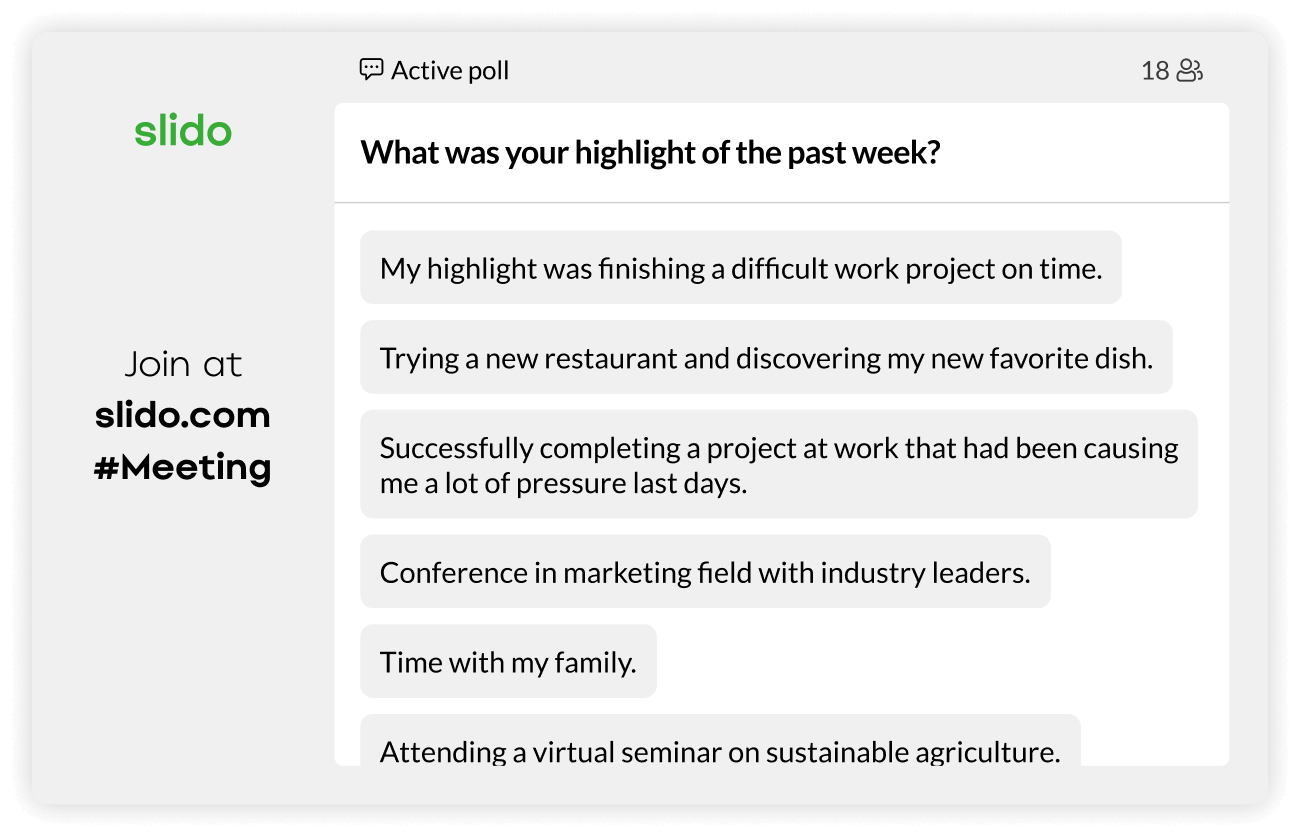
Inspirational
Help your team understand more about each other’s motivations by sharing what gets them going:
- Which industry figure inspires you and why?
- What was the best career advice you’ve ever received?
- What is your favorite moment from your time at the company to date?
Brainstorming
Run inclusive brainstorming sessions by framing them with well-crafted open ended questions:
- How can we improve our product?
- What steps should we take to achieve our goals for the following quarter?
- What are the biggest obstacles to prevent us from finishing this project on time?
Feedback
Understand how you can improve by introducing open ended questions into your feedback surveys:
- What are your main takeaways from this training?
- What can we do to improve these meetings in the future?
- What went well during our last project and why?
How to choose the correct poll type for open-ended questions
If you’re using Slido to facilitate your open-ended questions, you’ll want to make sure that you’re using the right poll type for the job.
The best fit for open-ended questions will be Slido’s open text poll. You can use this to collect insights from employees asynchronously or in real time.
This will allow you to ask respondents about their thoughts on a topic and there will be plenty of space for them to go into detail (10,000 characters to be precise).
Alternatively, Slido’s word cloud feature is a great way to simply check the mood in a meeting or quickly crowdsource what’s on people’s minds.
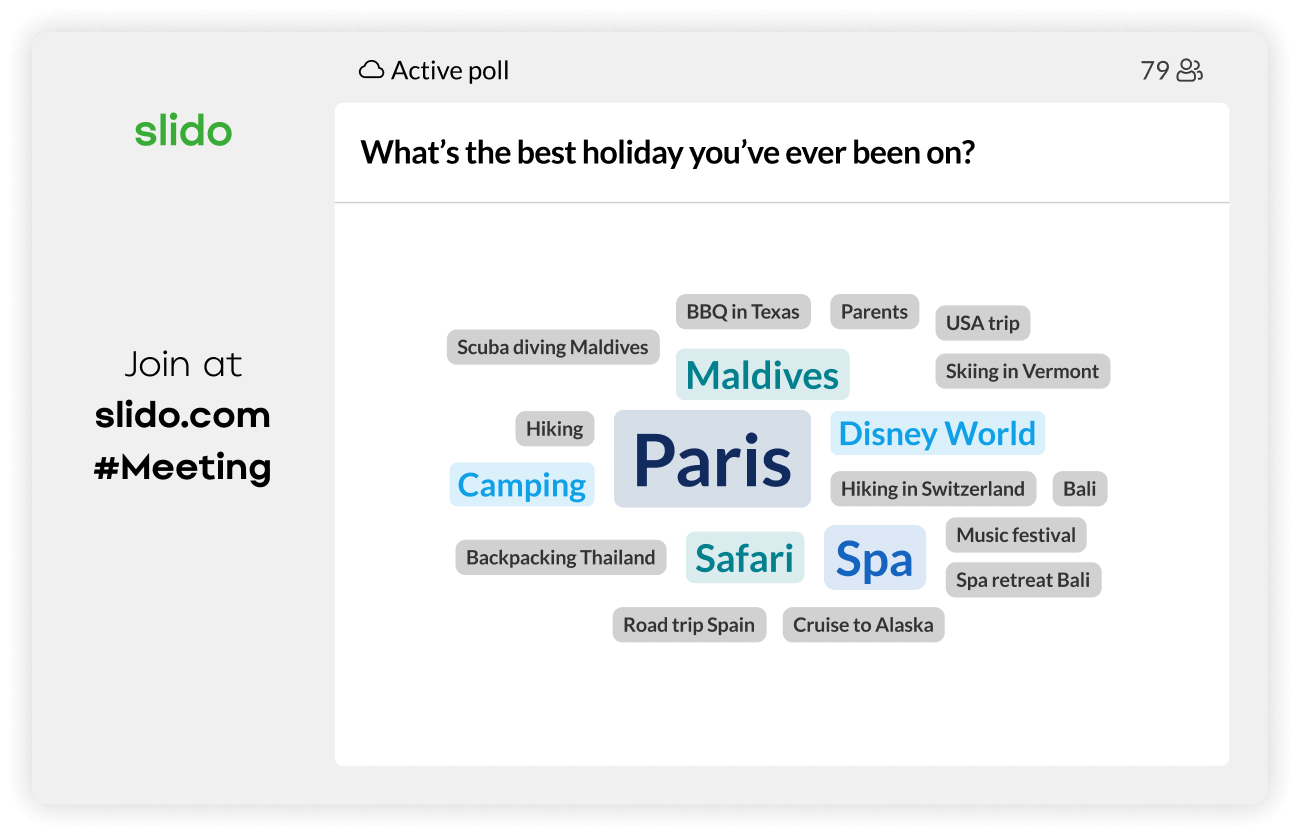
Since word clouds work best when the responses are just one or two words, it’s worth considering if this is the appropriate choice for your open-ended question.
If you want to give your team enough space to go into detail when expressing their thoughts, then an open text poll is a much better option.
How we use open-ended questions at Slido – a practical case study
We’ve become well acquainted with asking the right types of questions at Slido to make sure that we get that critical feedback, especially as a hybrid organization that works in many different countries.
To make working in a distributed team successful, we like to keep each other accountable by giving regular feedback on how things are going. We strongly believe that feedback is a gift and that it allows us to grow and learn.
This is how we use polls during our all-hands meetings to ensure we are all aligned and on course:
- Start with a themed word cloud poll to encourage connection between our people
- Throughout the main content, we aim for an interaction point every seven minutes. By combining open-ended and closed questions we can keep people engaged while facilitating questions
- We run our silent hero poll which has also been shared in advance for those in time zones that can’t join the meeting. This consists of two questions: who was your silent hero this month (word cloud) and feel free to leave a comment for your hero (open text).
- At the end of each meeting run a ranking poll to let people express how well the meeting went. This is a close-ended question.
- We combine this with a feedback box, so teammates can add their thoughts and comments to flag up what’s on their mind. This is a good example of an open-ended question.
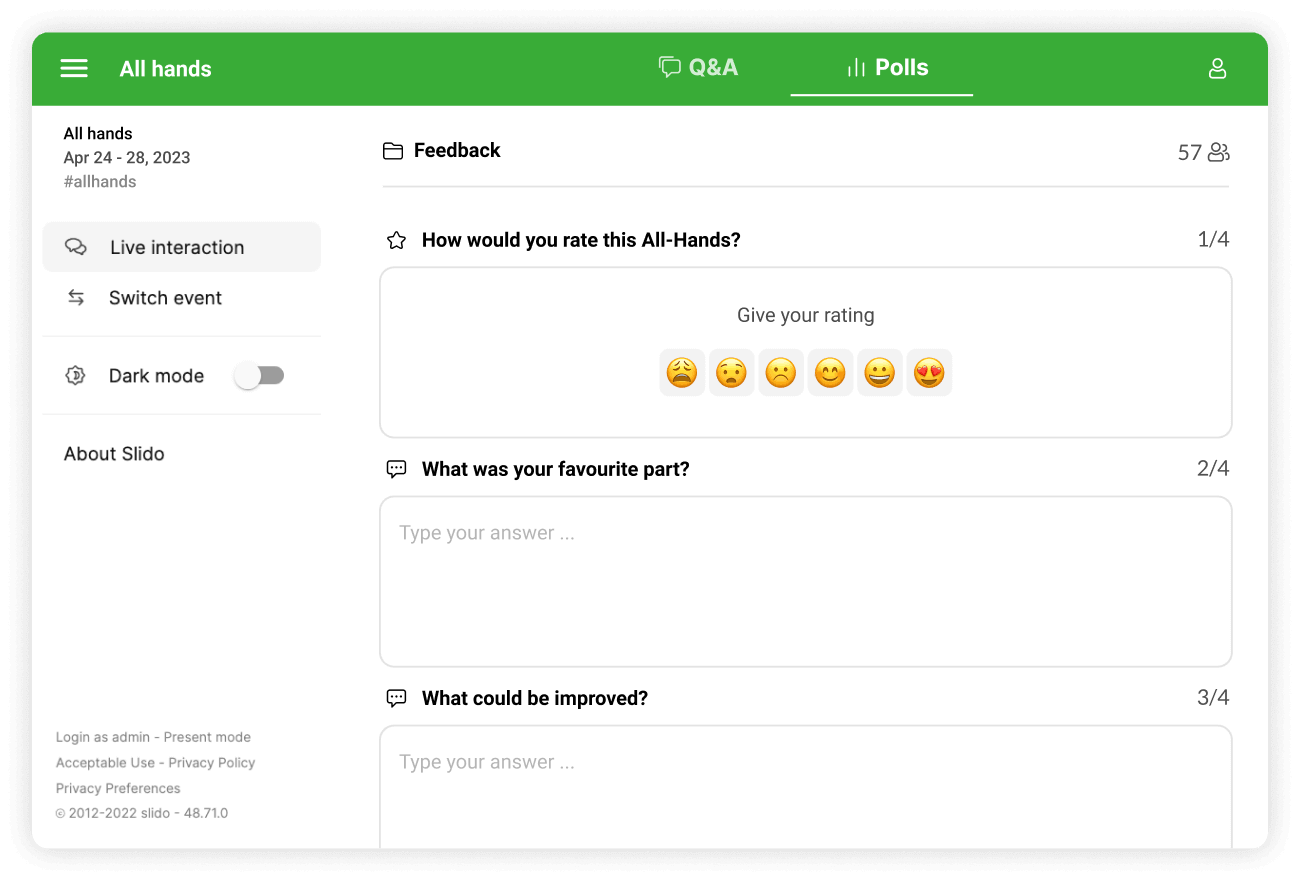
We leave the survey open so that everyone can leave their feedback, no matter their time zone, even when they’ll be watching the recording at a later time.
Final thoughts
To sum up, open-ended questions can be a highly effective means of discovering more about ourselves and our teammates.
By fostering an environment that promotes reflection, emotional response, and free expression, we can attain a deeper understanding of the thoughts and feelings of those around us.




